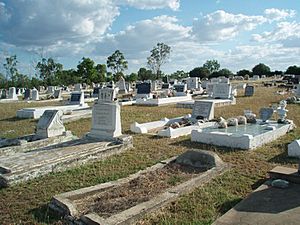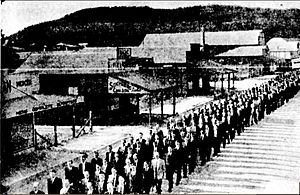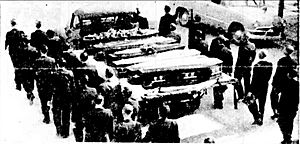Collinsville Cemetery, Queensland facts for kids
Quick facts for kids Collinsville Cemetery |
|
|---|---|

Collinsville Cemetery, 2007
|
|
| Location | Collinsville-Scottville Road, Collinsville, Whitsunday Region, Queensland, Australia |
| Design period | 1919–1930s (interwar period) |
| Built | 1927 - |
| Official name: Collinsville Cemetery, Collinsvillle-Scottville Cemetery | |
| Type | state heritage (built, landscape) |
| Designated | 18 September 2009 |
| Reference no. | 602730 |
| Significant period | 1927- |
| Lua error in Module:Location_map at line 420: attempt to index field 'wikibase' (a nil value). | |
The Collinsville Cemetery is a special heritage-listed cemetery in Collinsville, Australia. It was built starting in 1927. This cemetery is also known as Collinsville-Scottville Cemetery. It was added to the Queensland Heritage Register on September 18, 2009, because of its important history.
Contents
Discovering Collinsville Cemetery
The Collinsville Cemetery was officially opened in 1927. It was created to serve the mining towns of Collinsville and nearby Scottville. This was actually the second cemetery for Collinsville. The first one wasn't very good because the ground was too hard to dig graves.
Inside Collinsville Cemetery, you'll find the graves of seven miners. These miners tragically died in a big accident at the Collinsville State Mine on October 13, 1954.
How Collinsville Started
The town of Collinsville was first called Moongunya. This name is believed to be an Aboriginal word meaning "coal." The Railway Department gave it this name when the town was just a collection of simple huts and tents.
In 1918, the spot for the Collinsville State Mine was chosen. The mine began working in March 1919. The Queensland State Government wanted Collinsville to be a perfect example of a modern mining town. So, in 1921, they renamed it Collinsville. It was named after Charles Collins, who was a local politician for the area.
The government wanted to get rid of the old huts and tents. They asked experts to help plan the town's layout. The Department of Mines was in charge of running the town.
By 1922, many land plots had been sold. Collinsville had about 20 miners' houses, a store, a police station, a butcher shop, and a school. By 1925, around 800 people lived there. The town also had a hotel, a movie theater, a dance hall, and a hospital being built. The mine even provided water and electricity for the town.
Why a New Cemetery Was Needed
An earlier cemetery was set up north of Collinsville. But the ground there was extremely hard. Workers had to use explosives just to dig each grave!
In 1925, people realized this was a big problem. A local newspaper suggested that the old cemetery should be closed. They wanted a new cemetery where it would be easier to bury people.
Later in 1925, a public meeting was held. People chose trustees to manage the new Collinsville Cemetery. These trustees included people from both Collinsville and Scottville.
The new Collinsville Cemetery was officially opened on March 3, 1927. It covered about 20 acres of land. The very first person buried there was Agnes Ramage. She passed away on September 11, 1927, when she was 33 years old.
The Big Mine Accident
The Collinsville Cemetery is also where the miners who died in the Collinsville mine disaster are buried. Seven men lost their lives in the Number One Tunnel of the Collinsville State Coal Mine. This happened at 5:50 PM on Wednesday, October 13, 1954. About 40 miners were working underground at the time.
The accident was caused by a sudden burst of carbon dioxide gas. This gas was almost pure, about 98 percent, and it filled the mine shaft. The miners couldn't breathe and sadly passed away.
Two other men were also affected by the gas and had to go to the hospital. Mining staff and the local hospital superintendent worked together. They tried to rescue anyone still alive and recover the bodies of those who had died. By 11 PM that night, all the miners' bodies had been found.
News of the disaster spread quickly. People from all over the country sent messages of sympathy. Many miners stopped work to honor their friends who had died. Union officials and other groups also sent their condolences.
The funeral for the seven miners was held on Thursday, October 14, 1954, in Collinsville. The service took place in ANZAC Hall. A local storekeeper, Mr. E. Finch, led the service, helped by a minister from Bowen.
The funeral procession started at 4:30 PM. It was led by a group of miners, which was a traditional mining custom. The wives and children of the miners followed in cars. About 2000 people attended and walked the 2.4-kilometer journey to the Collinsville Cemetery.
Many union officials were at the funeral. They came from different mining and worker groups to show their support. After the disaster, miners and the public donated money to help the families who had lost loved ones.
Changes After the Disaster
Mining accidents like the one in 1954 often lead to better safety rules. The Collinsville accident led to new safety rules in the law. These rules required mine deputies to pass special tests. They also had to carry safety lamps and gas detectors during their inspections. Other disasters later led to even more safety changes.
To remember the lives lost in the 1954 disaster, the communities of Collinsville and Scottville hold a memorial service every year on October 13. In 2004, they held a special 50th-anniversary event. The families and friends of all seven miners attended. This event was held at the Collinsville Coal Face Experience, which honors all miners and especially those who died in 1954.
The victims of the Collinsville tragedy are still remembered by coal miners in Queensland. They are remembered along with those from other major mining accidents. The Collinsville accident is often mentioned at memorial events for the mining industry.
What the Cemetery Looks Like
The Collinsville Cemetery is reached by a long path from Collinsville-Scottville Road. It's located between the towns of Collinsville and Scottville. The cemetery has a section with headstones, a lawn section, and a special wall for urns called a columbarium. There's also a small shelter building.
The lawn section has slanted concrete strips. These strips have plaques with information about the people buried there. Flowers and other decorations are often placed near the plaques. Tall foxtail palms are planted along one side of this section.
The columbarium is a brick wall in the lawn section. It has many small spaces, and some of them hold urns. The middle rows of spaces are larger than the ones above and below them.
The shelter shed is right across from the front gate in the headstone section. This building has a sloped roof. One side is supported by a concrete block wall, and the other side by two wooden posts. There's a wooden bench inside. A native tree provides shade for the shelter.
The cemetery has many different types of memorials. These include headstones, large stone tombs, tall pillars, and altars. They are made in various styles and materials, with many different messages carved into them. The headstones are made from materials like marble, granite, concrete, and a type of stone called terrazzo. They range from simple flat stones to fancy memorials decorated with angels, bibles, and crosses.
The miners who died in the 1954 accident are buried in two rows of graves. Five are in one row, and two are in the other. Their names are Alexander Parkinson, Peter S Miller, James Reid Logan, Herbert Bernard Ruff, Arthur Henry Shrubsole, Frederick Ernest Walker, and Henry Peterson. Each grave has its own unique design and headstone.
For example, Parkinson's grave has a low concrete base with pale blue tiles. Miller's grave has a stepped concrete base and a marble plaque. Logan's grave has a concrete border and a special headstone with a curved top. Ruff's grave is covered with blue tiles and has a heart-shaped plaque. Shrubsole's grave has a concrete border and a light-colored headstone. Walker is buried in a double plot with a bronze plaque. Peterson's grave has a concrete headstone shaped like an open book.
Three tall, thin trees called pencil pines stand along a short path. This path leads from the front gate to the shelter shed. The cemetery has wide gates for cars and smaller gates for people walking. A wire fence surrounds the cemetery, which is located in a natural bushland area.
Why It's Heritage Listed
The Collinsville Cemetery was added to the Queensland Heritage Register on September 18, 2009. It met certain important requirements.
It shows how Queensland's history has changed. The cemetery is the burial place for at least 23 miners who died between 1928 and 1954. These miners were killed at the Bowen Consolidated Colliery and the Collinsville State Mine. This shows how dangerous underground coal mining was in the early 1900s. It helps us understand an important part of Queensland's mining history.
The cemetery holds the graves of the seven men who died in the October 1954 accident at Collinsville State Mine. This was Queensland's worst mining disaster in over 30 years. Because of this, the cemetery is strongly connected to an event that made people across the state pay attention to mine safety. It also led to new laws about mine safety practices.
It has a strong connection to a community or group. Since it's where the seven miners from one of the state's worst mining accidents are buried, the cemetery is very important to mining workers across Queensland. It reminds them of all the miners who have lost their lives at work. The Collinsville accident is often mentioned at memorial events held by the mining industry.



